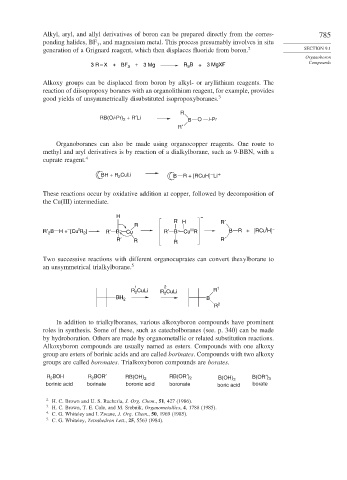Page 809 - Advanced Organic Chemistry Part B - Reactions & Synthesis
P. 809
Alkyl, aryl, and allyl derivatives of boron can be prepared directly from the corres- 785
ponding halides, BF , and magnesium metal. This process presumably involves in situ
3
generation of a Grignard reagent, which then displaces fluoride from boron. 2 SECTION 9.1
Organoboron
Compounds
3 R – X + BF 3 + 3 Mg R 3 B + 3 MgXF
Alkoxy groups can be displaced from boron by alkyl- or aryllithium reagents. The
reaction of diisopropoxy boranes with an organolithium reagent, for example, provides
good yields of unsymmetrically disubstituted isopropoxyboranes. 3
R
RB(Oi-Pr) + R′Li B O i -Pr
2
R′
Organoboranes can also be made using organocopper reagents. One route to
methyl and aryl derivatives is by reaction of a dialkylborane, such as 9-BBN, with a
cuprate reagent. 4
– +
BH + R CuLi B R + [RCuH] Li
2
These reactions occur by oxidative addition at copper, followed by decomposition of
the Cu(III) intermediate.
H –
R' H R′
R
I
I
III
R′ B H + [Cu R ] R′ B – Cu R′ B – Cu R B R + [RCu H] –
–
2
2
R′ R R R′
Two successive reactions with different organocuprates can convert thexylborane to
an unsymmetrical trialkylborane. 5
1 2 1
R CuLi R CuLi R
2
2
BH 2 B
R 2
In addition to trialkylboranes, various alkoxyboron compounds have prominent
roles in synthesis. Some of these, such as catecholboranes (see. p. 340) can be made
by hydroboration. Others are made by organometallic or related substitution reactions.
Alkoxyboron compounds are usually named as esters. Compounds with one alkoxy
group are esters of borinic acids and are called borinates. Compounds with two alkoxy
groups are called boronates. Trialkoxyboron compounds are borates.
R BOH R 2 BOR′ RB(OH) 2 RB(OR′) 2 B(OH) 3 B(OR′) 3
2
borinic acid borinate boronic acid boronate boric acid borate
2
H. C. Brown and U. S. Racherla, J. Org. Chem., 51, 427 (1986).
3 H. C. Brown, T. E. Cole, and M. Srebnik, Organometallics, 4, 1788 (1985).
4 C. G. Whiteley and I. Zwane, J. Org. Chem., 50, 1969 (1985).
5
C. G. Whiteley, Tetrahedron Lett., 25, 5563 (l984).

